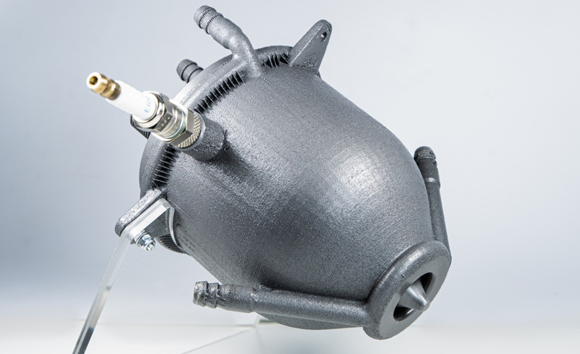Fraunhofer IWS & TU Dresden develop AM rocket engine with aerospike nozzle for microlaunchers
February 19, 2020

Researchers at the Fraunhofer Institute for Material and Beam Technology (IWS) in Dresden, Germany, and aerospace experts from TU Dresden (Dresden University of Technology) have collaborated to develop an additively manufactured rocket engine with an aerospike nozzle for microlaunchers. The scaled metal prototype is expected to consume 30% less fuel than conventional engines and has been tested by researchers on the test stand of the Institute of Aerospace Engineering at TU Dresden.
According to Fraunhofer IWS, microlaunchers are an alternative to conventional launch vehicles and capable of carrying payloads of up to 350 kg. These midsized transport systems are designed to launch small satellites into space and the market for them is expected to increase in the future due to movements by the UK to build a spaceport in Scotland, and the Federation of German Industries (BDI) endorsing the idea of a national spaceport.
Fraunhofer IWS states that the aerospike engine’s fuel injector, combustion chamber and nozzle were additively manufactured using Laser Powder Bed Fusion (L-PBF). The design consists of a spike-like centre-body which is designed to accelerate combustion gases.
“The technology behind aerospike engines dates back to the 1960s,” commented Michael Müller, Scientific Assistant at the Additive Manufacturing Center Dresden (AMCD), which is jointly operated by Fraunhofer IWS and TU Dresden. “But our ability to produce engines as efficient as this is owed to the freedom brought by Additive Manufacturing and its embedding in conventional process chains.”
Mirco Riede, Group Manager of 3D Manufacturing at Fraunhofer IWS, stated, “Every gram saved is worth its weight in gold in space flight because less fuel has to be taken into orbit. The heavier the overall system, the lighter its payload has to be.”
The project researchers are now looking to the injection system in a bid to further boost engine efficiency, as injectors reportedly pose major design and manufacturing challenges. This work is being undertaken as part of a collaborative project called CFDμSAT, and has been underway since January 2020 with the Ariane Group and Siemens AG as associated partners.
“Fuels first serve to cool the engine,” added Müller. “They heat up and are then induced into the combustion chamber. Liquid oxygen and ethanol are added separately to be blended via an injector. The resulting gas mixture is ignited. It expands in the combustion chamber and then flows through a gap in the combustion chamber to be decompressed and accelerated by the nozzle.”
The additively manufactured rocket engine prototype is expected to be featured at technology trade fair Hannover Messe 2020, which will take place in Hannover, Germany, on April 20–24, 2020.
















